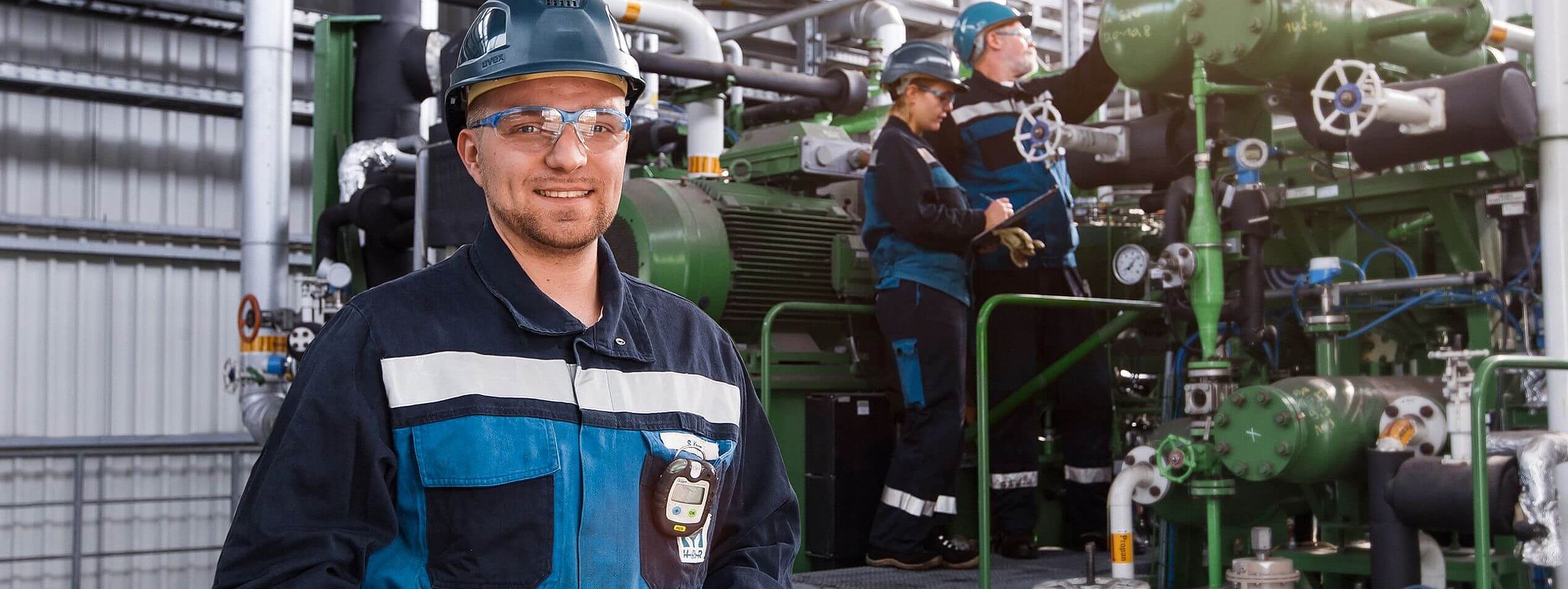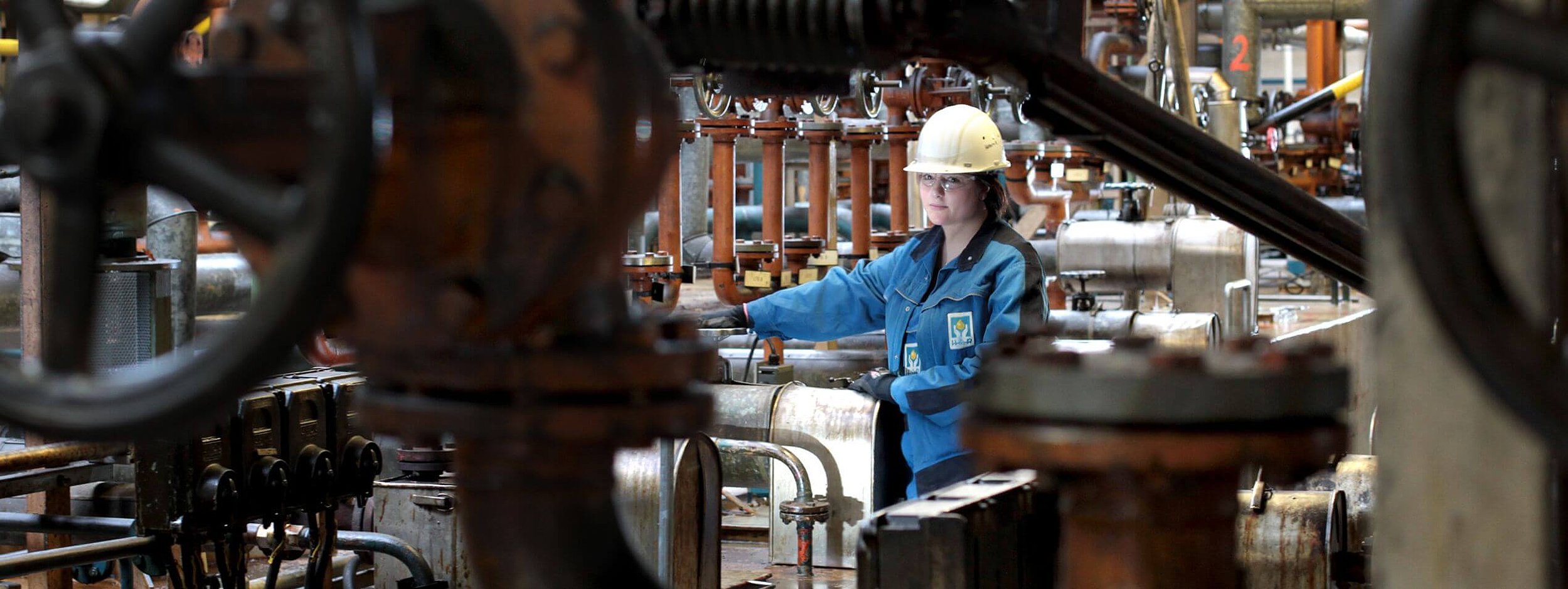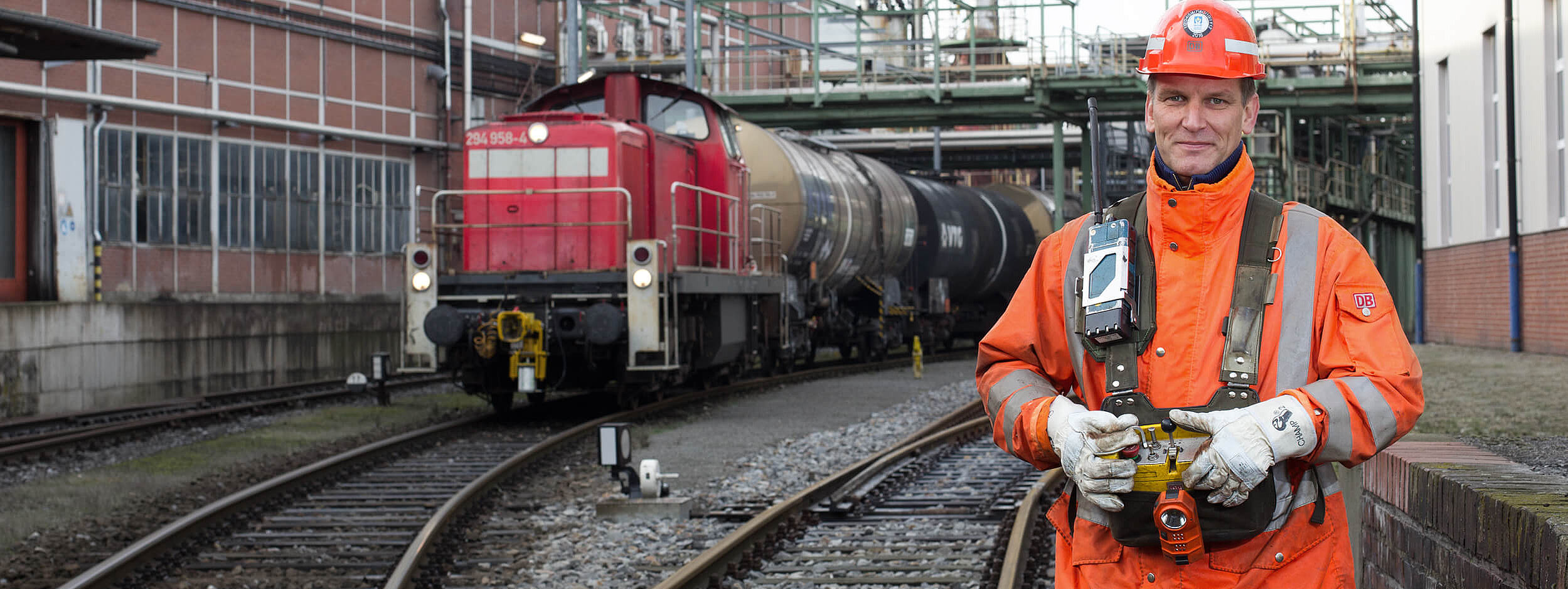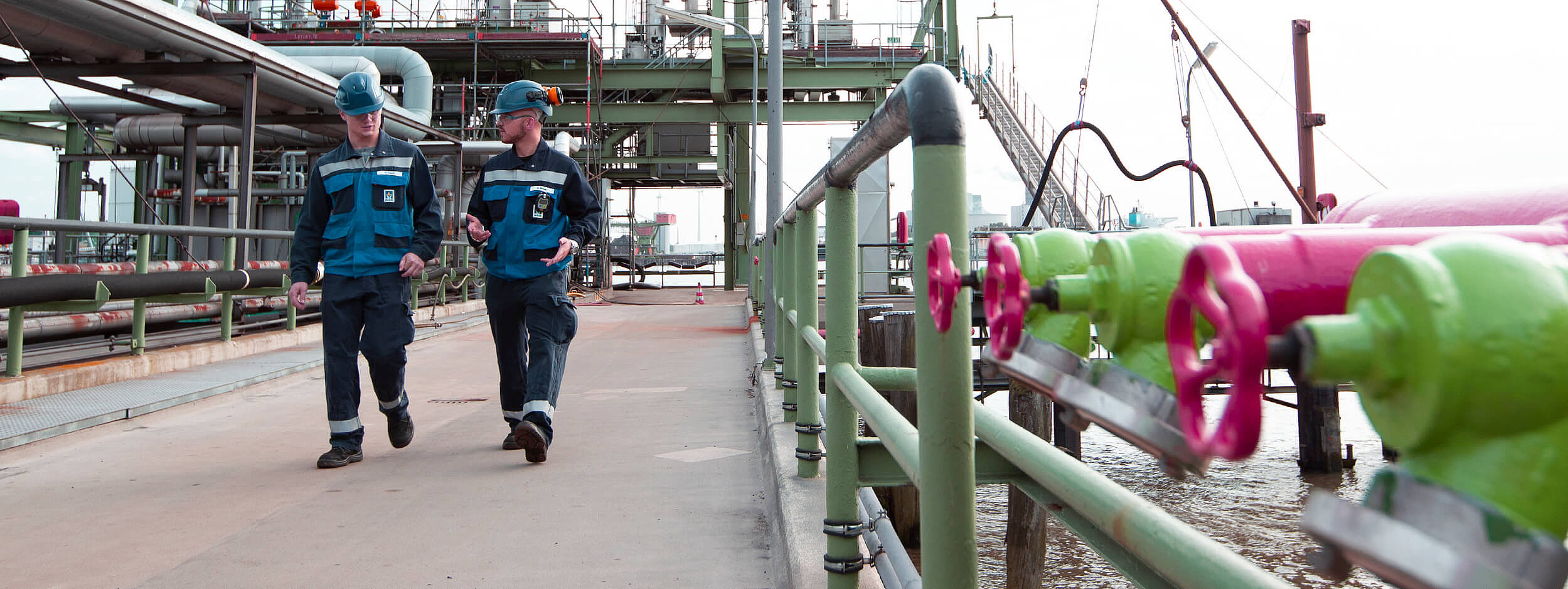
Employees
The motivation and qualification of our employees is essential for our corporate success. We want to create a positive work environment and support team spirit, commitment and respon-sible activity. In the past year, we had to distance ourselves once again and yet also grew closer together.
The Group has a structured corporate organization. This structure is laid out in organizational charts. Where this is not otherwise contractually stipulated, all Group employees have function and job descriptions which clearly cite their tasks, authorizations and responsibilities.
Our company’s success is also heavily dependent on the skills, performance capabilities and commitment of our employees.
Maintaining skill sets in the long term is therefore incredi-bly important; strengthening these is a goal of our training and education policy. We gain the performance capability and commitment of our colleagues by adhering to the appli-cable labor laws, by negotiating collective bargaining agree-ments or special corporate agreements as well as through a performance-based remuneration system. Protecting health was once again an important topic in 2021. The COVID-19 pandemic again forced us to set more short-term goals and measures.
Despite these challenges, it was our aim to ensure the oper-ational processes at our refineries, processing and sales lo-cations and thus to allow the heart of our company group to continue beating strongly. The fact that it was not necessary to stop operations entirely or even partially in 2021 is an indi-cation that our measures were appropriate. The latter includ-ed largely forgoing in-person dealings. We made extensive use of work-from-home options before the legal requirement to make such working conditions possible came into effect. Those who had to remain on site for operational reasons were protected by hygiene and social distancing rules, guidelines for the use of shared spaces and by the provision of masks and antigen rapid tests. We adapted our measures to the changing requirements, reassessed them at regular intervals and promoted them at all levels of the organization through meetings and by assigning dedicated contacts for specific issues. A clear definition of the procedures in advance meant we were able to address the handful of indirect and direct suspected cases of infection swiftly and fully. We also benefit-ed from a willingness among our employees to get vaccinat-ed, which led to a vaccination rate that was above the average in Germany or the respective country figures, according to a voluntary internal survey.
The human resources management of the H&R Group is orga-nized in such a way as to take into account site-specific and country-specific differences. Local human resources depart-ments at the sites tailor their human resources management approaches to fit country-specific requirements. The particu-lar conditions in local and regional labor markets pose a special challenge to the human resources management, as they sometimes differ greatly, such as in terms of demographics and level of education. They are supported by the Group human resources department in Hamburg.

Human Resources Management
Organization
At year-end 2021, the number of people employed by the H&R Group remained unchanged at 1,585. The following ta-ble shows a breakdown by segment:

A large number of our employees work at the German refin-eries in Hamburg and Salzbergen in the ChemPharm Refining segment (717 people (December 31, 2020: 699)) and at the GAUDLITZ GmbH site in Coburg (122 people (December 31, 2020: 147)) in the Plastics segment. At the end of the report-ing period, these locations had a workforce of exactly 839 (December 31, 2020: 846). At the international processing and sales sites of the Sales segment, a total of 476 workers were employed (December 31, 2020: 454).
We do not currently pursue any Group-wide goals in terms of the proportion of female employees. In the refineries with full-time shift operations as well as the Coburg site of the Plastics segment, the proportion of female employees was 19%. We have not set specific goals in terms of the propor-tion of female employees.
We currently only record the age structure of our German em-ployees. This has remained roughly the same in recent years. During the reporting period, the 51-to-60 age group made up the largest percentage. The age distribution is thus typical of industrial companies in Germany.
We believe that we benefit from the wide range of skills and the dedication of all our employees. We see the diversity of the people we employ as an asset. Employees with disabili-ties and health conditions are offered particular protection. We work closely with the relevant agencies to find solutions that enable employees with health restrictions to keep their jobs or move to a suitable position. This means we can retain skilled workers and keep long-standing, valuable knowledge within H&R. In 2021, our German sites had 23 employees with severe disabilities, accounting for 2.6% of the workforce. Of those, 17 employees were in the ChemPharm Refining seg-ment and six were in the Plastics segment.

Employee
Recruitment and Retention
In order to meet its economic and strategic corporate objec-tives, the H&R Group needs qualified employees for both its production sites and refining locations. The orientation of these goals is as clear as they are simple: We want to fill all open positions in a way that the profile requirements of the position and the skills profile of the employee fit together as best as possible. Human resources work therefore focuses on employee recruitment and retention. We use a differentiated approach to recruit employees. Open positions in the com-pany are advertised internally in collaboration with the em-ployee bodies. In business and administrative departments, we utilize online platforms and job fairs. For vacant executive positions, professional human resources consultants assist us with the search and selection.
When making our final decision in interviews, we take a com-prehensive look at the skills of the applicants and consider subject knowledge as well as social skills.
One of the main areas we focus on is recruiting young employ-ees as apprentices training to become chemical technicians or laboratory technicians. With regard to this, at the start of 2022 the H&R Group began to test innovative approaches, such as the Instagram account initiated by our current train-ees at the two refineries.
For new employees, the supervisor responsible for them cre-ates onboarding plans and qualification matrixes which detail job-specific aspects as well as instructions for site-specific systems such as an introduction to the IM system. Instruc-tion from qualified individuals on topics such as occupational safety, environmental protection, energy efficiency, operating dangers, accident protection, and how to act in the event of an alarm continue to be obligatory for new employees.
Our performance-related remuneration models and flat hierarchies also make us an attractive employer for experienced professionals. At the German sites, most employment con-tracts are subject to the terms of collective bargaining agree-ments. In addition, we offer our employees flexible work-ing hours (part-time arrangements, honor-system working hours), which – to the extent possible, given the processes and operating needs, such as shift work – they also take advantage of. During the pandemic in particular, the Group expanded its options for working remotely, i.e., not on-site or in the office.
The H&R Group operates the improvement suggestion man-agement system “Fit for Future” in Germany. The goal is to utilize the motivation and will of the workforce to make improvements, thus increasing corporate success and contrib-uting to job satisfaction. The task of all senior executives is to take suggestions from employees seriously and support these once they have been evaluated.

Training and
Continuing Education
As we can only compete internationally if we have superbly trained employees on board, we consider our spending on advanced training and professional development to be an investment in the future of our Group.
There are currently no Group-wide target figures for the number of trainees. This is due to the structure of German apprenticeships, which combines academic and on-the-job components, unlike in most companies. For the two refinery sites, conversely, target figures were defined for 2021 for the fields of chemical technicians, chemical laboratory assistants, warehouse logistics specialists and office managers and filled as follows:

Occupational Health
and Safety
Protecting the health of our employees is firmly anchored in the Group’s corporate policy. Motivated, qualified and, above all, healthy colleagues at all levels and in all Group companies contribute to the success of the company. This principle is part of our integrated management system. Its components – primarily the safety and risk management system – regulate how we define processes to uphold health and occupational safety within the Group and monitor their effectiveness.
The major legal regulations that govern the actions of our German Group companies as binding guidelines include the requirements of ISO 45001 on occupational health and safety, the law on company physicians, safety engineers and other specialists for occupational safety – the German Occupational Safety Act (ASiG) for short – and the German Social Accident Insurance Regulation 2 (DGUV V2). The organization of ap-pointed officers ensures adherence to these and monitoring of the relevant processes, training on this matter and report-ing to the executive level responsible.
Throughout the Group, the implementation of the corporate policy is carried out through observance and implementation of local laws and regulations.
In general, we act under the principle that all errors, be they accidents, damage to property or injuries, are preventable. Our goal is therefore a zero-accident approach. Events that occur nevertheless which are relevant for the health or oc-cupational safety of our employees as recorded Group-wide according to the standardized criteria of indicators LWIF (lost workday injury frequency – number of work accidents with at least one day lost for every one million working hours) and LWIS (lost workday injury severity – number of days lost per work accident). These are then reported to Group management.
Health Protection
in a Pandemic
As explained above, 2021 once again presented us with particular demands in terms of our duty of care toward our employees and the protection of their health. We want to promote the health of our workforce and maintain their performance in the long term. We embraced this responsibility comprehensively and kept our employees informed about the latest developments and recommendations. Throughout the Group, the management levels in particular were responsible for implementing the nationally applicable rules and for en-suring the greatest possible safety.
To give the German sites as an example, regular newsletters on the topic of Covid-19 were sent out to inform the employ-ees on the implementation of the recommendations of the federal government and the Robert Koch Institute, and clear rules were defined for internal workflows. The same applied to the international sites, which informed their workforce of local laws and government recommendations and set regu-lations for day-to-day working based on these. In addition to operational matters, rules for conduct were also included that were directly connected to day-to-day business, such as clear rules on work-related or private travel and return. The legal provision “3G at work” – vaccinated, recovered or tested – was also implemented at the affected production sites.
Throughout the year, a “coronavirus guideline” laid down un-ambiguous requirements regarding working together at the two refinery sites. In the event of queries, its actual imple-mentation was specified by a task force consisting of man-agement and HR heads with the backing of in-house medical staff.
This was accompanied by comprehensive hygiene regula-tions covering everything from the procurement of masks to the later provision of rapid tests and the implementation of a corresponding testing system.
As was previously done with the annual flu vaccination drive, the company also organized dates once the vaccine became available on which employees at the German sites could be vaccinated on-site against coronavirus by the company phy-sician. This comprised the first and second doses as well as booster vaccinations.
We also offer the employees at our production sites a com-prehensive approach to mobile working, under which our IT department continued to ensure our employees had the flex-ibility of working away from their usual workplaces in 2021. Comparable models also applied to employees at the international sites, where the regional rules and laws provided for such options.
